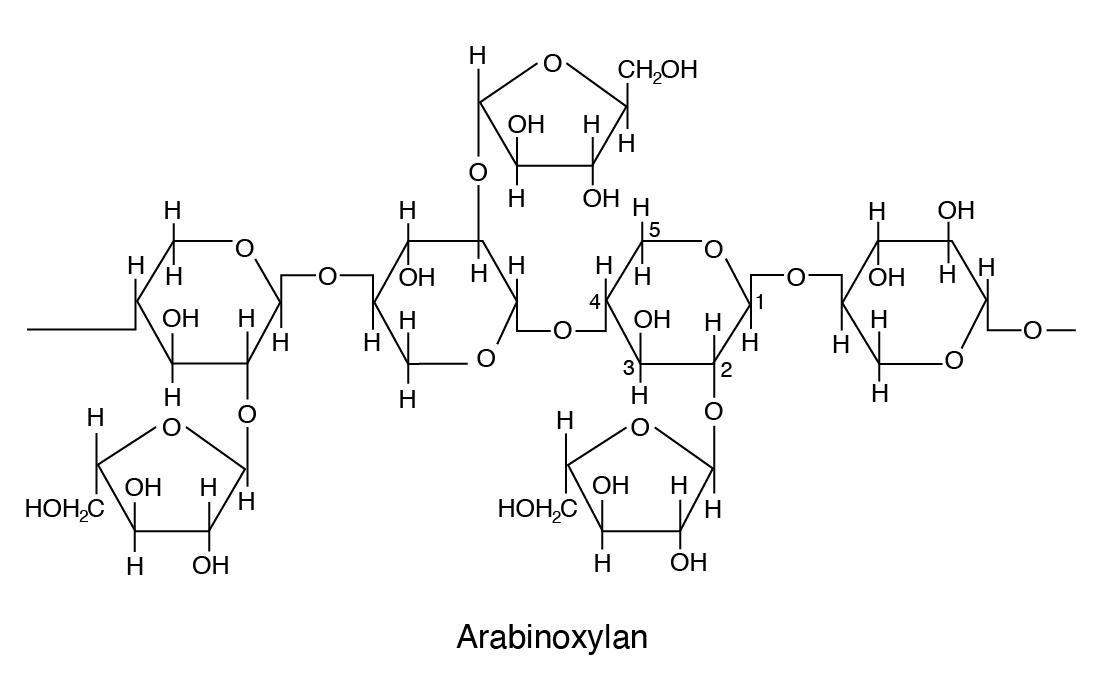XIX. Feed Additives
This chapter discusses the role, need, and use of different feed additives used in the diet of food-producing animals.
New Terms
Antibiotic growth promoters
Antioxidants
Carbohydrases
Enzymes
Feed additives
Nonstarch polysaccharides
Phytase
Pro/prebiotics
Tocopherols
Chapter Objectives
- To introduce different feed additives that are used in the diet of food-producing animals
- To discuss the role of feed additives in increasing nutrient digestibility, gut health, animal productivity, and food product quality
Why Use Feed Additives in Animal Diets?
Feed additives are minor components of the animal ration and are used for improving the quality/digestibility of feed and the nutritive and aesthetic quality of food or improving animal performance and health.
Feed Additives
- Enzymes
- Pro/Prebiotics
- Antioxidants
- Antibiotic growth promoters
Some of the most commonly used feed additives in animal rations include enzymes, pro- and prebiotics, antioxidants, antibiotic growth promoters, and coloring agents. Overall, these different ingredients are aimed at enhancing digestibility or availability of bound nutrients (e.g., enzymes), improving animal gut health (e.g., pro/prebiotics) and food product quality (e.g., antioxidants), reducing nutrient loss (e.g., phosphorus, nitrogen), and promoting environmental protection.
Enzymes
Exogenous enzymes are commonly added to the diet of monogastric animals as a means to reduce the antinutritional effects of the feed. Cereal grains and plant-based byproducts are the major components of the ration. Several nutrients present in these products are in a “bound” form, meaning that monogastric animals do not have the enzymes to digest and release the nutrients to make them available to the animal. Phytate phosphorous and nonstarch polysaccharides (NSP) are the two major antinutrients present in feed.
Phosphorus (P) in cereal grains are present as phytic acid (myo-inositol hexakisphosphate), the primary phosphate storage compound in seeds. Typically, phytic acid contributes 50% to 80% of the total phosphate in plant seeds.
The salt form of phytic acid is called phytate, and almost all phytic acid (Figure 19.1) is present as a mixed salt (phytin). Phytate P is poorly available to monogastric animals due to the lack of endogenous enzymes and can reduce the digestibility of other nutrients, affecting growth and performance.

Microbial phytase is the most commonly used exogenous enzyme in the feed for monogastric animals. Phytase (myo-inositol hexakisphosphate phosphohydrolase) catalyzes the stepwise removal of phosphate from phytic acid or its salt phytate. Phytase can reduce the antinutritional effect of phytate and improve the digestibility of phosphorous (P), calcium, amino acids, and energy, as well as reduce the negative impact of inorganic P excretion to the environment. Phytase efficacy varies among feedstuffs due to phytate solubility. Overall, the efficacy of exogenous phytase enzymes is affected by both feed (source of enzymes, solubility, particle size) and animal (gut pH, retention time) factors.
NSPs are a major part of fiber (fiber is the sum of NSP and lignin) and are regarded as feed components that are either poorly digested or have antinutritive properties. NSPs include water-soluble and insoluble components such as cellulose, lignin, arabinoxylan, glucan, and oligo- and polysaccharides containing different sugars such as arabinose, galactose, rhamnose, and mananose. The common NSP in rye and wheat are arabinoxylans, while barley and oats contain a high level of mixed-linked β-glucan (3%–4%; Figure 19.2).

High levels of the NSP in the diet of monogastric animals are associated with reduced growth and performance. Specifically, high-NSP diets increase digesta viscosity, decrease digesta mixing and digestibility, and delay transit of digesta through the intestinal tract and thus are a greater opportunity for pathogenic bacterial overgrowth.
Carbohydrases are enzymes targeted to act on complex carbohydrates (NSPs) and sugars. Various enzymes, including xylanase, ß-glucanase, and cellulase, have been reported to enhance the nutritive value of cereal byproducts for pigs and poultry. However, the efficacy of the enzymes depends on the solubility of the NSP and the complex nature of the carbohydrate. The future challenge for the feed industry is to produce highly efficacious enzymes that will lead to the utilization of both soluble and insoluble NSPs as an energy source for monogastric animals.
Pro/prebiotics
The term pro/prebiotics is used to designate organisms and or substances that contribute to healthy microbial balance in the intestine and include both living organisms and nonliving substances. Promoting favorable gut microflora is important especially when antibiotic growth promoters (AGPs) are phased out from animal feeds. Probiotics help prevent and control gastrointestinal pathogens and/or improve the performance and productivity of production animals through various mechanisms. Healthy microbial populations in the gastrointestinal (GI) tract are often associated with enhanced animal performance, reflecting more efficient digestion and improved immunity.
Probiotics are live microorganisms and are of bacterial and nonbacterial origin. With the exception of certain yeast and fungal probiotics, most of the microorganisms used are of bacterial origin. Examples of bacterial probiotics are several species of Lactobacillus, Bifidobacterium, Bacillus, and Enterococcus. Nonbacterial (yeast or fungal) probiotics include Aspergillus oryzae, Saccharomyces and Candida pintolopesii.
Supplementation of probiotics has been shown to increase the population of beneficial microorganisms, such as Lactobacilli and Bifidobacteria. These healthy bacterial colonies then inhibit the growth of harmful microorganisms by producing substances (e.g., bacteriocins and/or organic acids) and by competitive exclusion. Thus probiotics serve as an alternative to antibiotic feed additives to manage and reduce pathogen load by reducing intestinal colonization and spread of other enteric pathogens. Probiotics have been shown to be effective in reducing postweaning diarrhea in piglets and morbidity and mortality in pigs.
Lactobacillus and Bifidobacterium species are common choice as probiotics.
Prebiotics are nondigestible functional ingredients that selectively stimulate the growth of favorable bacteria in the gut of the host (food for the good microbes). Prebiotics are classified as disaccharides, oligosaccharides, and polysaccharides, and most commonly used prebiotics include lactulose, mannan-oligosaccharide (MOS), inulin, and fructooligosaccharides (FOS).
Antioxidants
With the advent of rations containing a high level of animal and vegetable fats, the requirement for antioxidant protection has become very apparent. Oxidation occurs in feeds and feedstuffs, resulting in the rancidity of fats and destruction of vitamins A, D, and E and amino acids, resulting in lowered energy values for the diet. Antioxidants are added in animal diets to improve the quality of feed and to increase shelf life. Antioxidants are of two types, natural and synthetic products. These products have the ability to prevent or terminate free radical production thereby providing protection against reactive oxygen species. Through these processes, antioxidants minimize rancidity of oils while enhancing shelf life along with feed quality.
Natural antioxidants include tocopherols, followed by other aromatic plant extracts (e.g., rosemary extract) and essential oils. The natural form of vitamin E is RRR-α-tocopherol. Synthetic vitamin E consists of a mixture of different stereoisomers and is called all-racemic-α-tocopherol or all-rac-tocopherol. One IU of vitamin E is equal to 1 mg of all-rac-α-tocopherol acetate. In the feed industry, vitamin E is available commercially as all-rac-α-tocopherol acetate and RRR-α-tocopherol acetate.
Other synthetic compounds with antioxidant properties include ethoxyquin (generic term for 1,2-dihydro-6-ethoxy-2,2,4-trimethylquinoline), butylhydroxytoluene (BHT), and butylhydroxyanisole (BHA). Ethoxyquin, however, has been demonstrated to be the most efficacious, followed by BHT and BHA.
Antibiotic Growth Promoters
The growth-promoting effects of antibiotics were discovered in the 1940s when chickens were fed feed containing byproducts of tetracycline fermentation. Since then, the use of growth promoters has been expanded to include a wide range of antibiotics that are applied to several species.
Antibiotic growth promoters are substances administered at a low subtherapeutic dosage in the feed for disease control and to enhance animal growth and performance.
The use of AGPs has risen with the intensification of livestock farming due to increased consumer demand and improvements in feed conversion to animal-derived foods. A wide range of veterinary antibiotic (natural, synthetic, or semisynthetic) compounds with antimicrobial activity are used as feed additives for disease control (prophylactic) or as growth promoters in livestock farming. These products offer proven benefits in animal health and food production, as well as a reduction of foodborne pathogens.
Antibiotics are not the only substance added to animal feeds. Anabolic steroids and β-agonists have been largely used in intensive meat production to improve nutrient availability and lean meat deposition in food animals. The recombinant bovine somatotropin (rBST) has been used to enhance milk production in the dairy industry. β-agonists (cimaterol) are a class of substances that act on adrenergic receptors with anabolic effects in animals. Anabolic steroids enhance lean meat deposition and muscle protein accretion and metabolize fat stores, resulting in increased lean growth rates and are used in animal production systems to increase growth rate, feed efficiency, and carcass leanness. Anabolic feed additives have been banned in the European Union; however, in the United States, two hormones are approved as feed additives: melengestrol acetate for feedlot heifers and ractopamine for swine.
The excessive use of antibiotics, particularly at a subtherapeutic dosage to promote growth, can fuel the development of antibiotic-resistant bacteria, which puts the health of both animals and humans at risk. Antibiotics also enter the environment through animal excreta and wastewater, as do anabolic growth enhancers, which can be particularly detrimental to aquatic animals.
Several manufacturers of antibiotics have voluntarily withdrawn AGPs from the market for nontherapeutic use in the US. Many countries regulate, but do not prohibit, their use for growth promotion in animals.
Others
In addition to the major additives listed previously, there are several other minor ingredients included in the feed depending on species, types of feed, and market. These include natural or synthetic pigmenters to enhance egg yolk and broiler skin color (e.g., carophyll, lutein, zeaxanthin), mold inhibitors to prevent mold growth (e.g., organic acids), mycotoxin binders that bind to the mycotoxins and prevent them from being absorbed, coccidiostats to prevent coccidiosis (protozoan infection in poultry), and pellet binders to reduce feed dust and help pellets adhere better.
Key Points
Enzymes
1. Phytases
Enzyme used to release P from phytic acid and increase P retention
2. Carbohydrases
Enzymes used to degrade complex carbohydrates
Probiotics
• Mixed cultures of live protective microbes
• Lactobacillus and Bifidobacterium
Prebiotics
• Nondigestible functional ingredients and “food for the good microbes”
• Oligosaccharides and polysaccharides
• Most commonly used
Antioxidants
• Prevent oxidation of lipids by scavenging free radicals (e.g., tocopherols)
• Provide protection from reactive oxygen species and increase shelf life.
Antibiotic Growth Promoters
• Prophylactic use, prevent the growth of harmful organisms
◦ For example, Rumensin, Amprolium, ionophores
• Growth promotion
◦ For example, Bacitracin, virginiamycin
Review Questions
- List the benefits of including feed additives in animal diets.
- Differentiate between probiotics and prebiotics.
- A researcher added phytase enzyme to the diets of broiler bids and measured fecal and bone phosphorus (P) content and it turned out to be as follows:
- Fecal P increase and bone P decrease
- Fecal P decrease and bone P increase
- Both fecal and bone P increase
- Both fecal and bone P decrease
- List any two feed additives that could be used to modulate gastrointestinal microbes and could be used as alternatives to antibiotic growth promoters in food animal production.
- What are non starch polysaccharides (NSP) and how do they influence monogastric animals’ growth and health?
- What are antibiotic growth promoters (AGP) and list any two AGPS used in animal production.

